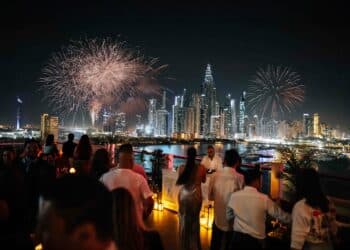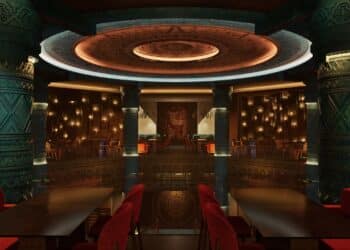The tourism and hospitality industry is a major pillar of the UAE economy, contributing 8% of GDP in 2015. With the country forecasted to register 4% growth this year Sophia Soltani reports on the growing tourist arrivals and their impact on the economic outlook.
With the performance of the UAE’s hospitality sector weakened by a surge in new supply, macroeconomic factors have put pressure on room rates and occupancy levels and recent reports from the likes of STR, Colliers International and Knight Frank also highlight a decline in RevPar and ADR due to the knock-on effect the Russian Ruble, weakened oil prices and political instability in neighbouring countries. 
But all is not lost, with tourism in the UAE growing rapidly, benefiting from an expanding range of regional and global air travel connections and improved accessibility for foreign visitors. The 2016 Q1 Tourism Report from BMI states tourism arrivals are expected to show healthy growth throughout the forecasted period until 2019, providing a valuable boost to other key markets.
Unlike many of its neighbours, the UAE boasts a stable political and economic environment with no shortage of international and domestic investor interest, and the hospitality sector continues to strive supported by extensive government investment in transport infrastructure, construction incentives and other tourism related infrastructures.
A Competitive Market
Dubai and Abu Dhabi are undoubtedly the two most developed areas in terms of international tourism and hotel developments in the UAE, but overall the country is looking to expand the success of these two leading emirates into other areas, such as Sharjah and Ajman, in order for the whole country to benefit. Both international and domestic hotel groups have invested significantly in the country over the past few years, and we have seen the entry of a number of major brands such as Hyatt and Carlson Rezidor to the market, attracted by both the potential performance of the country and government incentives such as the decision in 2013 to waive the 10% municipality fee for new 3- and 4-star properties in Dubai, whose construction will complete in 2017.
Abu Dhabi in particular is set to enjoy a prosperous few years as the city has started to broaden its hotel base in the same manner as the rest of the country.
Investment in business infrastructure, such as the Abu Dhabi World Trade Centre and the National Exhibition Centre, is aimed at attracting further business tourism, and numerous museums have been developed to attract cultural visitors. Sporting events are also being actively encouraged such as Formula 1, and overall the city is in a promising place for growth.
One of the major trends being seen in the UAE in terms of hotel development is the expansion of the rather neglected budget and mid-range sectors. Accor opened the largest budget hotel in the Middle East in Q1 2016, the ibis One Central in the Dubai World Trade Centre District, aimed at business and leisure travellers, which signals a change in things to come.
Historically seen as a luxury destination, the introduction of more affordable hotels has opened up the UAE tourism industry to a much wider demographic and this has gone hand in hand with the development of family-friendly activities such as theme and water parks, which helps to draw in a target audience not previously focused on by the country.
This diversification has not come at the cost of the luxury sector, which is still very much important to the country, but has helped the industry expand to become a truly global and well-diversified holiday destination. The expansion of this sector has also brought additional benefits to the UAE, including the mid-market hotel sector which is less seasonal than the luxury sector, boosting the hotel market and the wider tourism industry throughout the year. It has also allowed the country to attract a younger target audience than previously eluded it.
Reports indicate that hotel expansion is set to consolidate by 2016 end, with little growth expected until 2019 according to STR, but the total number of overnight stays will however continue to increase as visitor numbers rise. The UAE is also expected to see a slight improvement in the average length of stay – though for many visitors the region will remain a short-break destination, either on its own or as part of transit to further destinations according to Knight Frank’s 2015 overview report.
Eyes on Ajman
As Ajman is perhaps classed as one of the less prominent emirates, recent figures released by Ajman Tourism Development Department (ATDD) revealed that total tourism revenues for 2015 reached AED359 million, an increase of 19% compared to 2014. The report highlights that total guests in Ajman in 2015 reached 509,658 while total guest nights reached 1,392,406 with the majority of the guests booking their stay in a hotel or hotel apartments indicating a rise in average occupancy for hotels in Ajman. Last year the emirate reported an average room rate of AED514, while hotel apartments recorded average occupancy of 68%.
Figures also reveal that guests from the UAE remain the strongest contributor with 132,455 guests in 2015 followed by GCC nationals, Asians and Africans coming in third place with 89,113. Other nationalities who visited the emirate came from Europe, America, Russia, CIS countries, New Zealand, Australia and other Arab countries; showing not just domestic appeal but international interest too.
In 2015, Ajman saw five new establishments added onto the inventory, bringing the total number of hotels to 36, equating to 3,354 hotel rooms. With a promising outlook, HE Faisal Al Nuaimi, general manager of ATDD says: “The report is extremely encouraging knowing that the tourism industry in the UAE has been affected by the drop in the influx of holidaymakers from key markets coupled with low oil prices, currency fluctuations and regional unrest. We anticipate continued growth this year after the launch of Ajman’s new destination brand which will help position the emirate as a leisure and investment destination.”
Sharjah bound
After a testing time in 2015, Sharjah’s hospitality market is set to bounce back after the number of hotel and hotel apartment guests fell in 2015, according to Sharjah Commerce and Tourism Development Authority (SCTDA). SCTDA released data in early January detailing that the emirate expects the number of guests in to grow by 3.5% in 2016 from the 1.79 million seen in 2015, as a result of the authority’s focus on attracting tourists from the GCC and growing tourism source markets such as China, India and Europe through promotional campaigns.
As Sharjah’s guest numbers fell last year due to the weaker Ruble against the US Dollar, which the UAE dirham is pegged to, it made a holiday in the country more expensive for Russian visitors, and the slump in the Euro made Europe a cheaper and more attractive holiday destination for travellers from the GCC, but despite the slump, the SCTDA is still promoting the emirate to visitors from Russia and CIS countries, as the Authority believes that the reduction in numbers is “temporary.”
“The number of guests in Sharjah fell 13% last year from 2.06 million in 2014”, explains Gurdish Singh Bassi, project director at GRMC Advisory Services. “The number of visitors from Russia declined 75% but hotel and hotel apartment revenues reached AED670 million last year. I expect the market to start turning positive by the fourth quarter of 2016 as the appreciation of the US Dollar subsides and the oil prices start picking up,” adds Bassi.
Also anticipating the return of Russian visitors to start returning to Sharjah by the end of this year, he adds: “I don’t expect the Russian tourists to contribute as much as they did. They contributed over 25% of visitors five years ago and now they contribute only 9%.” Sharjah announced its tourism vision last year to nearly double the number of tourists in the next five years from 5.6 million in 2014 to 10 million and there are 53 hotels and 52 hotel apartments currently in Sharjah.
RAK on the map
Ras Al Khaimah could arguably have the most ambitious plans amongst the emirates having announced its Vision for 2018 in aiming to attract one million visitors by the end of 2018. The 2018 Vision is set to provide a strategic roadmap for Ras Al Khaimah’s tourism sector, encouraging growth and diversification across the accommodation portfolio, its tourism offering for both business and leisure travellers, the events sector and supporting infrastructure as well as the investment into destination marketing campaigns. Other targets include increasing the average length of stay from 3.1 days to 3.6 days and encouraging repeat visits. With three key areas of the 2018 vision, Haitham Mattar, CEO, Ras Al Khaimah Tourism Development Authority says: “Ras Al Khaimah has already been recognised as the fastest growing emirate in terms of tourism. Under the guidance of His Highness Sheikh Saud Bin Saqr Al Qasimi, the Council Member and Ruler of Ras Al Khaimah, the emirate has seen impressive growth in visitor numbers across all of our top source markets, and we have laid out the Vision for 2018 to further build on this success.”


































































